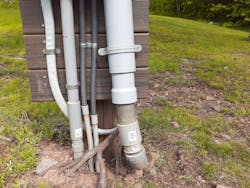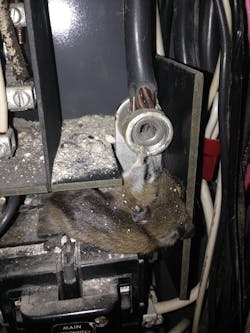All references are based on the 2020 edition of the NEC.
Mismatched Wiring Methods
EC&M reader Fred Bauer, a journeyman electrician with Hartery Construction, was kind enough to share this photo with us. He spotted this transfer switch installation in Hunter Mountain, N.Y. Using rigid PVC conduit couplings with liquidtight flexible nonmetallic conduit (LFNC) does not satisfy Code requirements. Section 300.15 requires fittings and connectors to be “used only with the specific wiring methods for which they are designed and listed.” Section 356.42 states “only fittings listed for use with LFNC shall be used.” PVC conduit fittings are not listed for use with LFNC. Misusing fittings in this manner is also a violation of Sec. 110.3(B), since they are not listed for this application. On a positive note, the installer did take the time to install expansion couplings on the PVC conduits emerging from the ground. Section 300.5(J) requires direct-buried cables, conductors, and raceways subject to movement from ground settlement or frost heaves to be arranged to prevent damage to the raceway or the enclosed conductors. Using flexible wiring methods or expansion fittings can also be used to satisfy this requirement. For PVC conduit exposed to physical damage, schedule 80 PVC conduit should be used as specified in Sec. 352.10(F).
Unlucky Rodent
This photo was sent in by Stephen M. Daniels, president of Daniels Electrical Contractors in Lancaster, Pa. “I was doing a service call for a dead circuit (forgive the pun) and took the panel cover off,” says Daniels. “There were missing knockouts, and that’s how the furry panel guest got in. This is another reason why the Code calls for no open KO in panels or boxes.” I completely agree with you, Stephen. Installing knockout seals in unused openings can help keep out the critters. It can also help keep out dust, moisture, and other contaminants/foreign objects that can damage the equipment. Section 110.12(A) requires unused cable and raceway openings to be closed in a manner that provides “protection substantially equivalent to the wall” of the enclosure. Installing knockout seals can also help keeps arcs and sparks from escaping the enclosure and possibly igniting adjacent combustible materials. Section 408.7 requires unused circuit breaker and switch openings to be closed with identified closures or some other approved means providing protection equivalent to the enclosure walls. Keeping the unused openings closed can also reduce the risk of accidental contact with energized parts.
About the Author

Russ LeBlanc
Owner
Russ started in the electrical trade as an apprentice in 1985. He worked his way up to become a Journeyman Electrician and then eventually became a Master Electrician and Licensed Construction Supervisor. In 1999 Russ become an Electrical Instructor for The Peterson School of Engineering in Massachusetts where he developed his passion for teaching, and quickly became Department Head of Electrical Instruction. Russ has taught thousands of apprentices, electricians, engineers, inspectors, and other electrical professionals during his career as an instructor. He continues to provide electrical professionals with Electrical Code seminars, Arc-Flash Awareness training seminars and educational material through his LeBlanc Consulting Services in North Reading, MA whose specialty is educating electricians. He has been an active member of the NFPA Electrical Section and has authored hundreds of National Electrical Code proposals and comments which have become Code rules to improve the safety for the electrical industry. Russ is also an IAEI certified Electrical Inspector.
Please visit www.russleblanc.net for more information.


